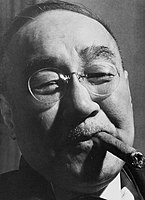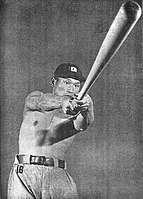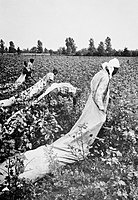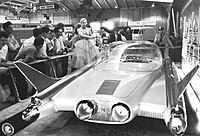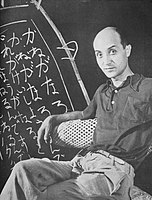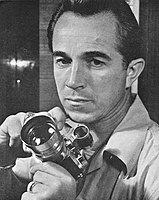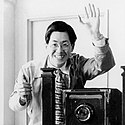Džun Miki
| Džun Miki | |
|---|---|
 | |
| Narození | 14. září 1919 prefektura Okajama |
| Úmrtí | 22. února 1992 (ve věku 72 let) Tokio |
| Alma mater | Univerzita Keió |
| Povolání | fotograf |
| Ocenění | Řád posvátného pokladu 3. třídy |
| Některá data mohou pocházet z datové položky. | |
Džun Miki (三木淳, Miki Jun, 14. září 1919 – 22. února 1992) byl japonský fotograf a jeden z japonských průkopníků fotožurnalismu.[1] Výběrová komise salónu Nikon zavedla v roce 1999 cenu Džuna Mikiho, aby si připomínala jeho odkaz. Studoval fotografii u Kena Domona a Júsaky Kamekury. Jeho kamarádem byl fotograf Takamasa Inamura.
Knihy zobrazující Mikiho díla
- Dokjumentarī no džidai: Jónosuke Natori, Kimura Ihee, Domon Ken, Džun Miki no šašin kara (ドキュメンタリーの時代:名取洋之助・木村伊兵衛・土門 拳・三木淳の写真から) / The Documentary Age: Fotografie Jónosuke Natori, Kimury Ihee, Domona Kena a Miki Jun. Tokio: Tokijské metropolitní muzeum fotografie, 2001. Katalog výstavy. Titulky v japonštině i angličtině, další text pouze v japonštině.
Galerie
- Sigeru Jošida na obálce magazínu Life, 1951
- Tetuharu Kawakami, pořízeno stroboskopem, který byl v té době velmi vzácný a byl jediným v INP Communications, 10. února 1950
- Miki Sees America, Černoši sklízejí bavlnu, 1954
- Miki Sees America, Stanley Marcus, prezident nejlepšího obchodního domu Niemann Marcus, 1954
- Miki Sees America, automobil budoucnosti na autosalonu, 1954
- Isamu Noguči, 1951
- David Douglas Duncan, 1950
Odkazy
Reference
V tomto článku byl použit překlad textu z článku Jun Miki na anglické Wikipedii.
- ↑ (japonsky) Tokijské muzeum fotografie, editor. 328 Outstanding Japanese Photographers. Kyoto: Tankōsha, 2000. ISBN 4-473-01750-8
Související články
Externí odkazy
 Obrázky, zvuky či videa k tématu Džun Miki na Wikimedia Commons
Obrázky, zvuky či videa k tématu Džun Miki na Wikimedia Commons
Média použitá na této stránce
"It was just the cotton harvest season in Vixberg. I met a black worker being carried by a poor truck like a cart. The sight made me think of America before the Civil War. In the field, black people were long dragging a white bag and picking cotton. I felt that the scale insects were moving, and I was absorbed in shooting. Suddenly, the farmer's grandmother said, "You will take a picture of the farmer exploiting the workers and send it to Moscow." America at that time was very nervous about communism. The idea of making communism evil had permeated every corner of America. "" Jun Miki Photobook LIFE's Camera Eye "Shogakukan, 1989.
The explanation by Miki is as follows. "I first used a strobe in 1948. I was working for an American INP news agency at the time, and I was written by a baseball critic named Daisuke Miyake, who was the director of the former giant army. There was a request in the book "Batting Theory" to photograph Tetsuharu Kawakami, who had just returned to the Giants.
I took a picture of Kawakami's shirtless swinging bat and the best opportunity to use one strobe at INP.
This strobe emits a flash of 1 / 100,000 seconds, so the bat of Kawakami, who is shaking strongly, was captured exactly, and the moment that could not be captured by the flash bulb was captured. "NIKKPR CLUB" No.136, 1991 SpringAt the motor show held at a part of the state fair, "the car of the future" was exhibited. This was a proto type manufactured for the show and was not commercially available. I think it was because of the rich America of the 1950s that I could afford to make such a luxurious sample car. "Jun Miki Photobook LIFE Camera Eye" Shogakukan, since 1989.
It was said that "Stanley will not be interviewed at all. Even a photographer of LIFE cannot take a picture", but when Miki visited, he accepted the picture in the luxury women's clothing in his department store.
Isamu Noguchi, 1951 Ars Photo Yearbook Highest Award Winner.Photograph taken by Jun Miki.The explanation of the work by Miki is as follows. "On the morning of his arrival in the United States, he invited me to come and see the exhibition. I helped Noguchi take a picture at the venue. I finally took a commemorative photo of Noguchi. After meeting Noguchi many times, I felt that Noguchi was a very smiley and innocent person. I wanted to take Noguchi as it was, and his father I shot him with the last poem of Yone Noguchi in the background. The model, Isamu Noguchi, background, Yone Noguchi, and lighting were taken by his younger brother Michio. This is a picture that the Noguchi family helped me when I took it."
Jun Miki in Tokyo. Around 1950.
D.D. Duncan Photographed by Miki on the ROLLEIFLEX automat on June 10, just before the Korean War service.
Prime Minister Shigeru Yoshida, the Ambassador of Japan to the signing ceremony of the San Francisco Peace Treaty in 1951, was still not well known overseas. This photo, which became the cover of "LIFE", was explained as "Shigeru Yoshida, who loves the country, loves the people, loves his family, and loves cigars, is called Churchill in Japan." Approximately 1,800 copies ran around the world, Approximately 1,800 copies, including the USA version and the international version, ran around the world. I am secretly proud that I was able to appeal to the whole world before the peace treaty. Jun Miki recalls.
